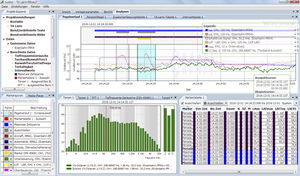
- Software - Simulation
- Software
- Measurement software
- Sinus Messtechnik GmbH
Analysis software µREMUSmeasurementfor aeronauticsreal-time
Add to favorites
Compare this product
Characteristics
- Function
- analysis, measurement
- Applications
- for aeronautics
- Type
- real-time
Description
This signal analysis software package mainly designed for mechanical engineers is perfectly suited for use with the Soundbook, Apollo and Tornado hardware platforms. It provides the operation and testing engineer with synchronous, high-resolution, digital measuring channels and outputs for lab, testing and field applications.
The µ-REMUS software package is highly versatile and offers almost unlimited possibilities to expert instrument technicians. During measurement the desired results are displayed in up to 32 real-time windows. Simultaneously the measured values are stored to the hard drive and can be accessed for any type of analysis. In addition to the measured values typically needed for mechanical engineering, airborne sound measurements (third octave, FFT, level) may be recorded and analysed.
Multiple formats (WMF, wav, µGraph, etc.) are available for data storage and output.
The µ-REMUS features in short:
Signal analysis
Order analysis
Modal analysis
Rotor balancing
For the SIGNAL ANALYSIS µ-REMUS includes:
Time history: A-, B-, C, KB-, MS-weighted,
FFT: Real, imaginary, amplitude, phase, Nyquist,
Power and cross spectra,
Transfer function, coherence,
1/1-, 1/3-, 1/12- and 1/24-octave analysis.
The µ-REMUS ORDER ANALYSIS allows the on- and off-line recording and analysis of start-up and run-out operations with:
Amplitude, order and octave display,
Waterfall and Campbell diagrams,
Crank angle degree scaling,
Rotational vibration analysis.
The MODAL ANALYSIS uses transfer functions, which have been recorded using the SIGNAL ANALYSIS. You can also import transfer functions in UFF format.
The following modal values are determined:
Natural frequency,
Catalogs
No catalogs are available for this product.
See all of Sinus Messtechnik GmbH‘s catalogs*Prices are pre-tax. They exclude delivery charges and customs duties and do not include additional charges for installation or activation options. Prices are indicative only and may vary by country, with changes to the cost of raw materials and exchange rates.








